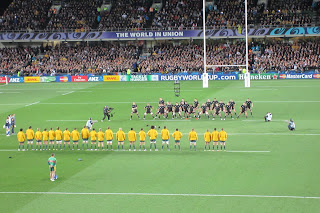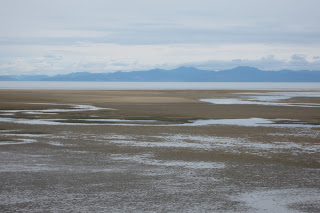Waiheki Island is stunning. It's about a half-hour ferry ride from downtown Auckland, and home to wineries, beaches, olive groves, and very expensive homes. You can see downtonw Auckland in the picture above if you enlarge it.
Downtown from a park near the History Museum.
Looking towards downtown from Mt. Hobson Park.
Also from Mt. Hobson, this is Rangitoto Island, a scenic preserve. It's about 850 feet tall, 3 miles across, and it grew out of a volcano that erupted in the middle of the bay about 700 years ago.
France beat Wales in the first semi-final. A key player from Wales was thrown out of the game for making a controversial tackle, and they had to play a man down for more than half the match. The ref called it exactly as the rules require, but wow, in a semi-final match for the World Cup?
I'm sure that everybody's favorite match was NZ vs. Australia. Can't beat the atmosphere for this one. Talk about a home-field advantage, though. Australia hasn't won a match at Eden Park in 20 years.
Looking back on it all, I can only say that this has been the trip of a life-time. I hiked some of the most beautiful scenery in the world, watched the highest level of rugby played in the sport's most revered stadium, and shared it all, including great food and drink, with my best friends and rugby teammates that I've known for 25 years.
Doesn't get any better that that.





















